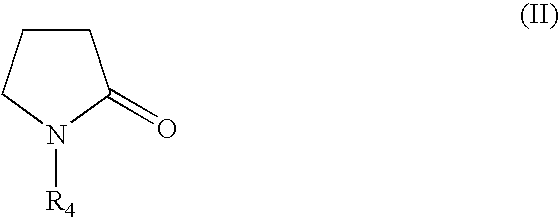Over-coating agent for forming fine patterns and a method of forming fine patterns using such agent
a technology of over-coating agent and fine pattern, which is applied in the direction of adhesive types, coatings, photosensitive material processing, etc., can solve the problems of significant variation in pattern dimensions, difficulty in controlling the thickness of resist pattern layers to be formed on the sidewalls of the wafer, and difficulty in maintaining the in-plane uniformity of wafers, so as to improve the thermal shrinkage of over-coating agent and achieve effective fine pattern formation , the effect of high ability to control th
- Summary
- Abstract
- Description
- Claims
- Application Information
AI Technical Summary
Benefits of technology
Problems solved by technology
Method used
Image
Examples
example 1
[0080]A copolymer of acrylic acid and vinylpyrrolidone [5.83 g; acrylic acid / vinylpyrrolidone=2:1 (polymerization ratio)], triethanolamine (0.53 g), acrylamide (0.58 g) and “PLY-SURF A210G”, product of Dai-ichi Kogyo Seiyaku Co., as phosphate esters of polyoxyethylene surfactant (0.06 g) were dissolved in water (93 g) to prepare an over-coating agent.
[0081]A substrate was whirl coated with a positive-acting photoresist TArF-7a-52 EM (product of Tokyo Ohka Kogyo Co., Ltd.), and baked at 115° C. for 90 seconds to form a photoresist layer in a thickness of 0.40 μm.
[0082]The photoresist layer was exposed with a laser exposure unit (Nikon S-302 of Nikon Corp.), subjected to heat treatment at 100° C. for 90 seconds and developed with an aqueous solution of 2.38 mass % TMAH (tetramethylammonium hydroxide) to form photoresist patterns which defined hole patterns with an each diameter of 161.0 nm.
[0083]Then above-described over-coating agent was applied onto the substrate including the hole ...
example 2
[0084]A copolymer of acrylic acid and vinylpyrrolidone [6.14 g; acrylic acid / vinylpyrrolidone=2:1 (polymerization ratio)], glycerol (0.18 g), acrylamide (0.62 g) and “PLYSURF A210G”, product of Dai-ichi Kogyo Seiyaku Co., as phosphate esters of polyoxyethylene surfactant (0.06 g) were dissolved in water (93 g) to prepare an over-coating agent.
[0085]Then above-described over-coating agent was applied onto the substrate including the hole patterns (each diameter of patterns: 161.0 nm) which was prepared in the same manner as described in EXAMPLE 1, and subjected to heat treatment at 150° C. for 60 seconds. Subsequently; the over-coating agent was removed using pure water at 23° C. The each diameter of the hole patterns was reduced to 121.7 nm.
example 3
[0086]A copolymer of acrylic acid and vinylpyrrolidone [6.14 g; acrylic acid / vinylpyrrolidone=2:1 (polymerization ratio)], glycerol (0.18 g), methacrylamide (0.62 g) and “PLYSURF A210G”, product of Dai-ichi Kogyo Seiyaku Co., as phosphate esters of polyoxyethylene surfactant (0.06 g) were dissolved in water (93 g) to prepare an over-coating agent.
[0087]Then above-described over-coating agent was applied onto the substrate including the hole patterns (each diameter of patterns: 161.0 nm) which was prepared in the same manner as described in EXAMPLE 1, and subjected to heat treatment at 150° C. for 60 seconds. Subsequently, the over-coating agent was removed using pure water at 23° C. The each diameter of the hole patterns was reduced to 122.6 nm.
[Second Type of the Over-Coating Agent for Forming Fine Patterns]
PUM
| Property | Measurement | Unit |
|---|---|---|
| mass % | aaaaa | aaaaa |
| boiling points | aaaaa | aaaaa |
| mass % | aaaaa | aaaaa |
Abstract
Description
Claims
Application Information
 Login to View More
Login to View More - R&D
- Intellectual Property
- Life Sciences
- Materials
- Tech Scout
- Unparalleled Data Quality
- Higher Quality Content
- 60% Fewer Hallucinations
Browse by: Latest US Patents, China's latest patents, Technical Efficacy Thesaurus, Application Domain, Technology Topic, Popular Technical Reports.
© 2025 PatSnap. All rights reserved.Legal|Privacy policy|Modern Slavery Act Transparency Statement|Sitemap|About US| Contact US: help@patsnap.com



